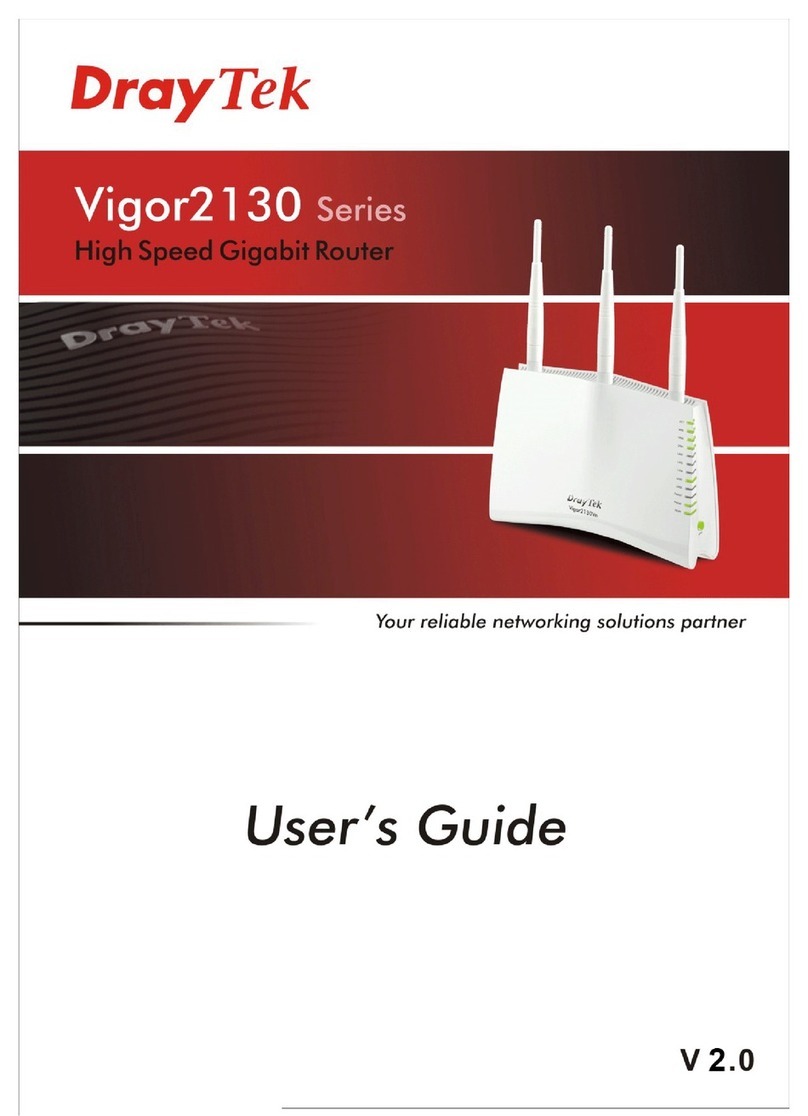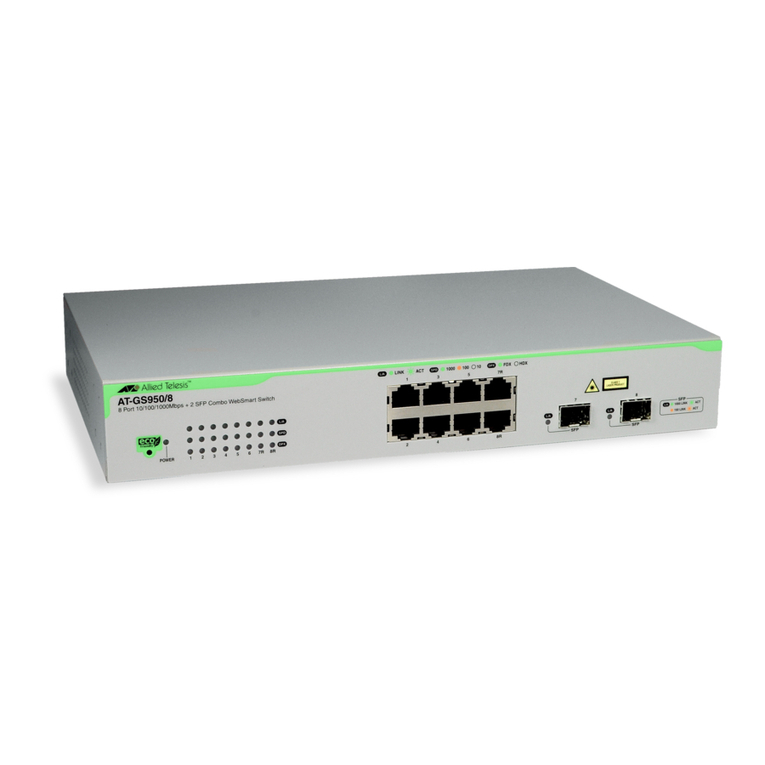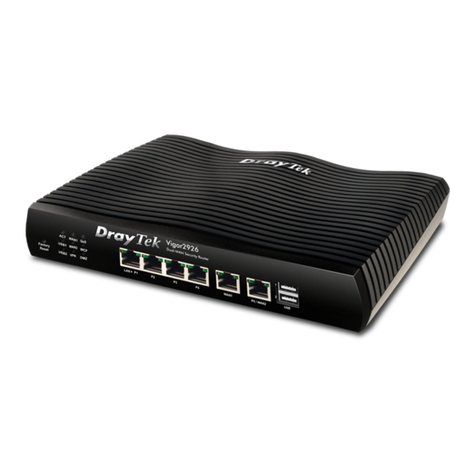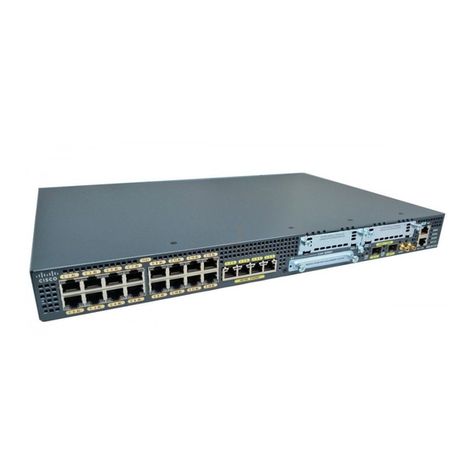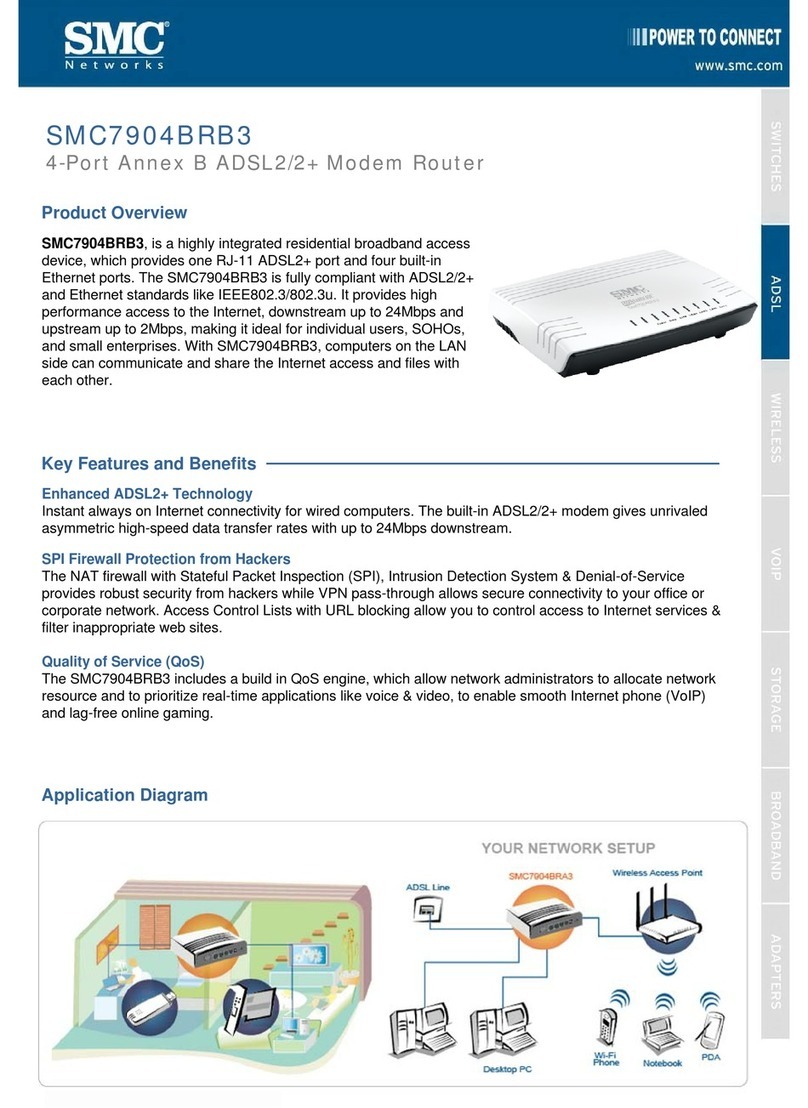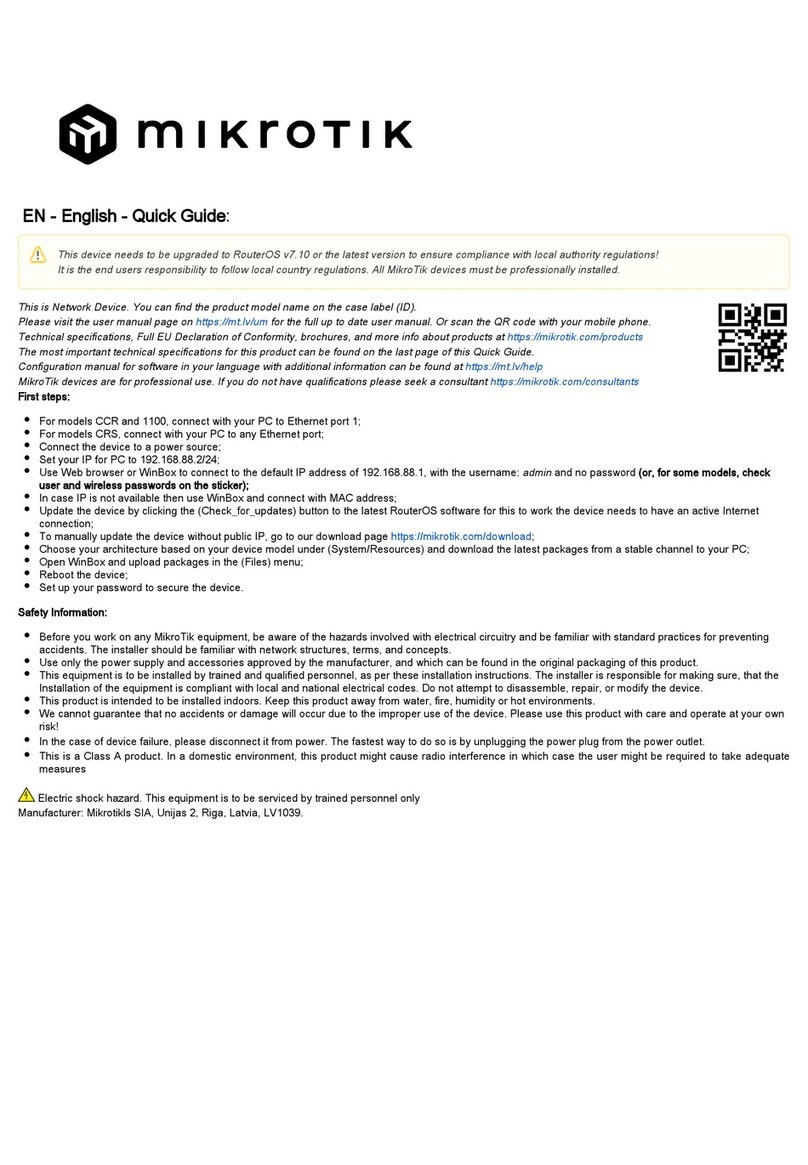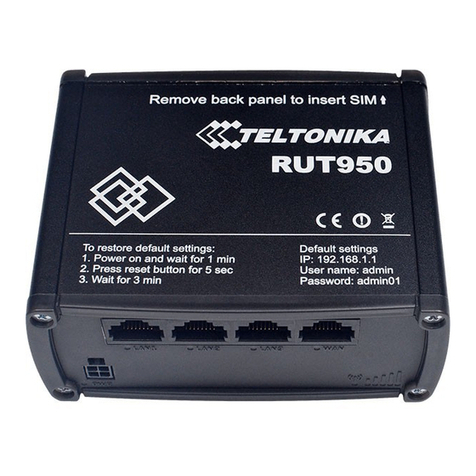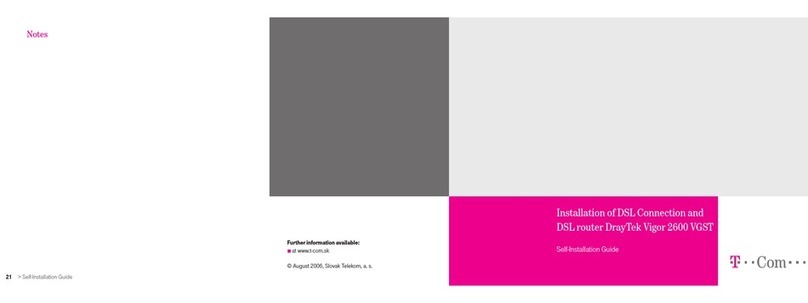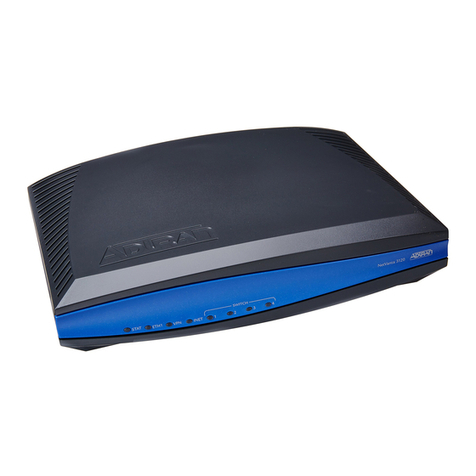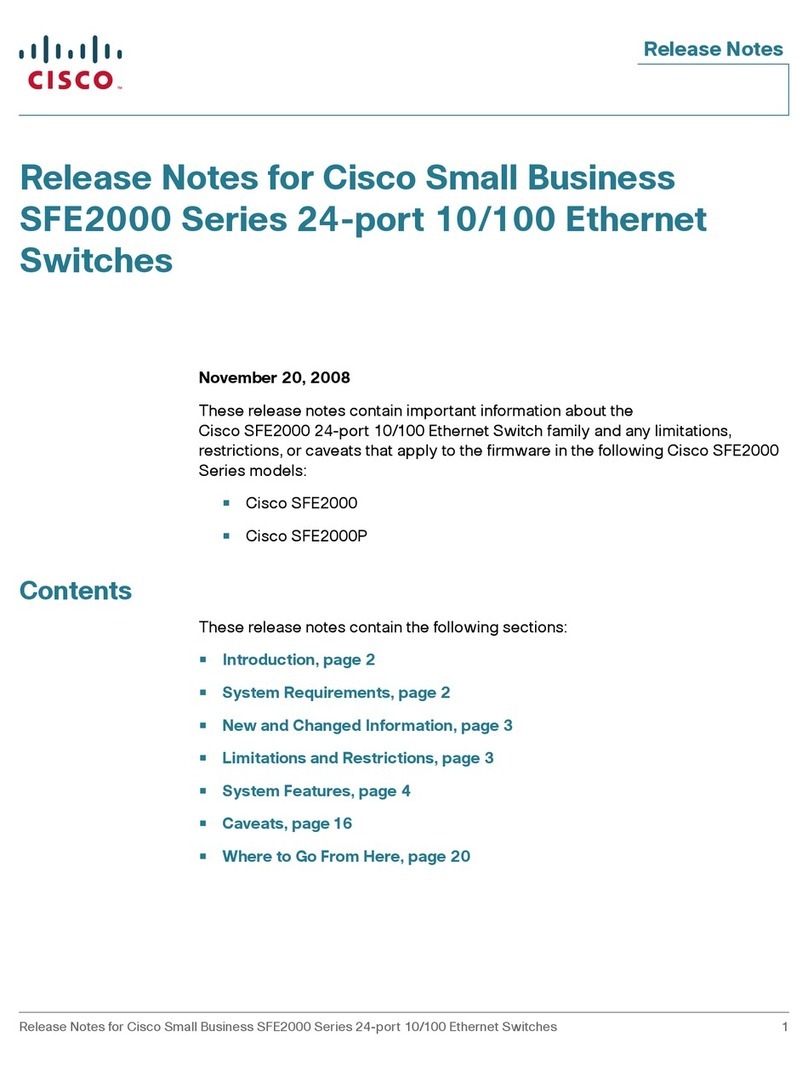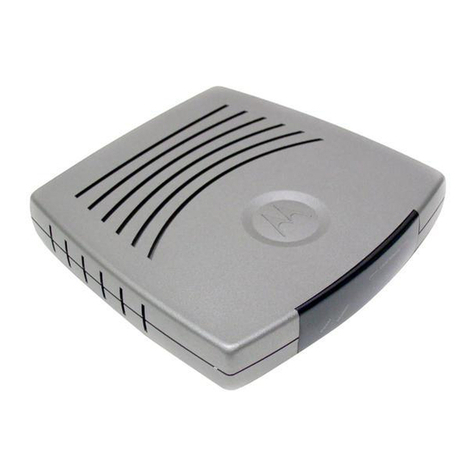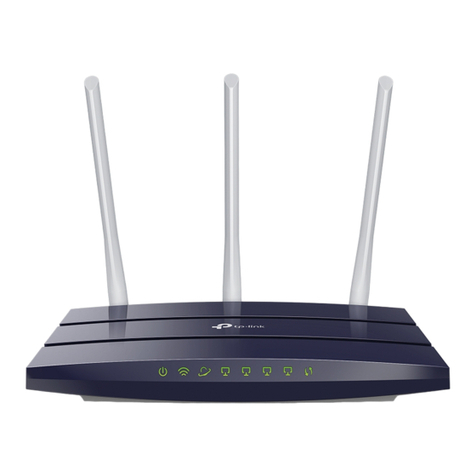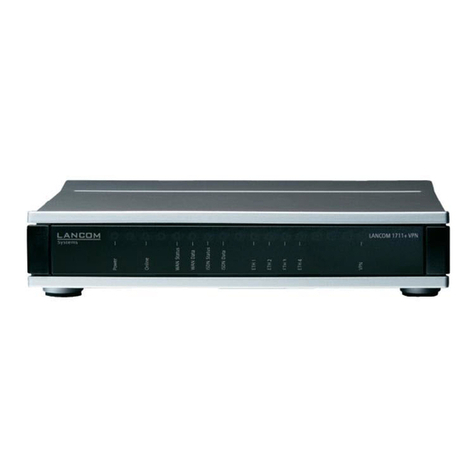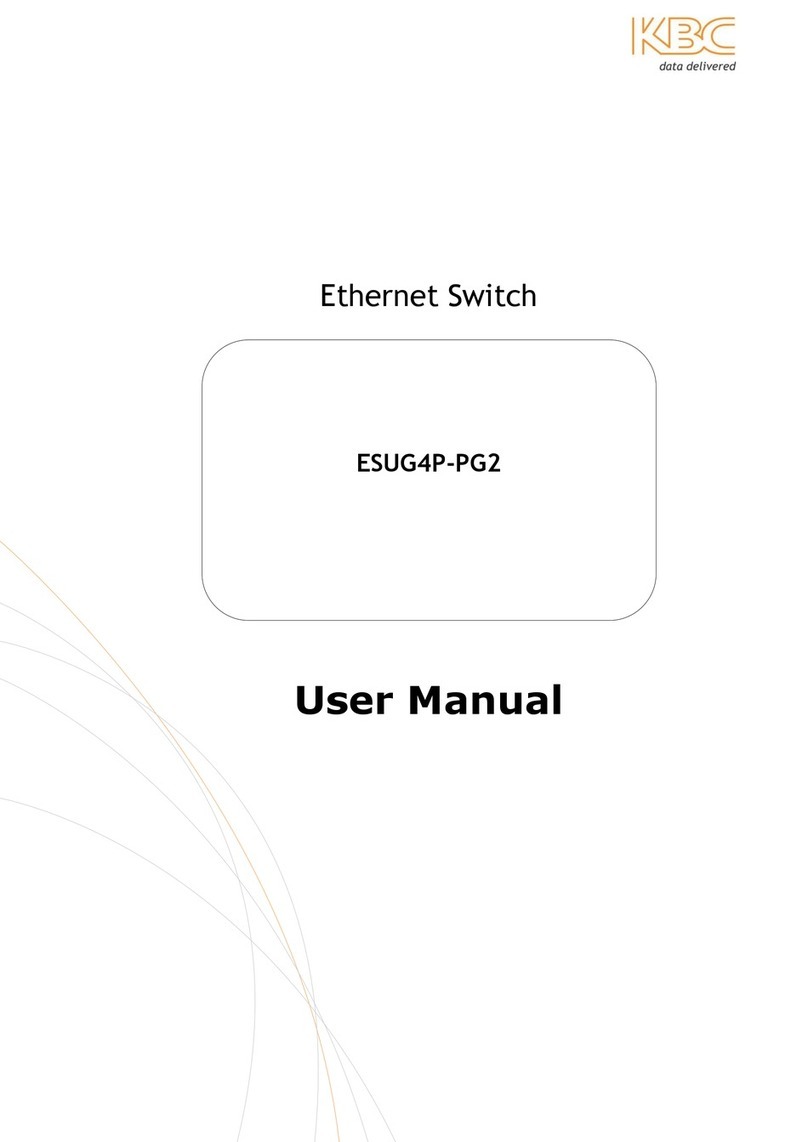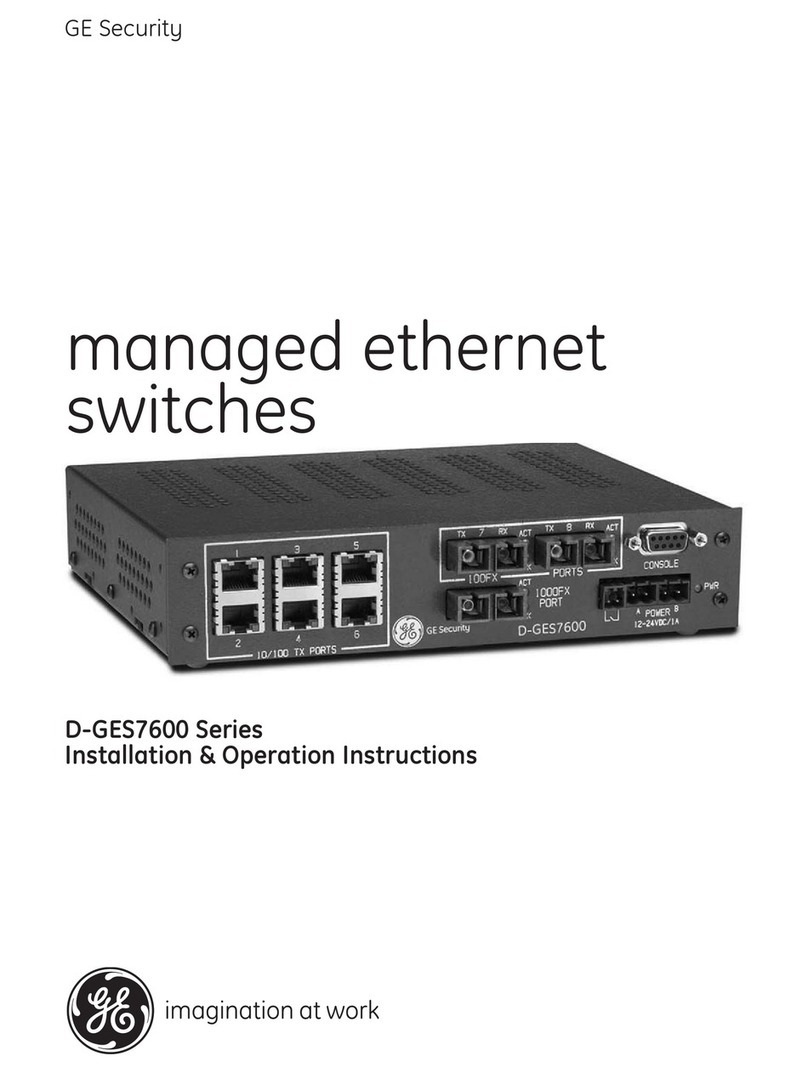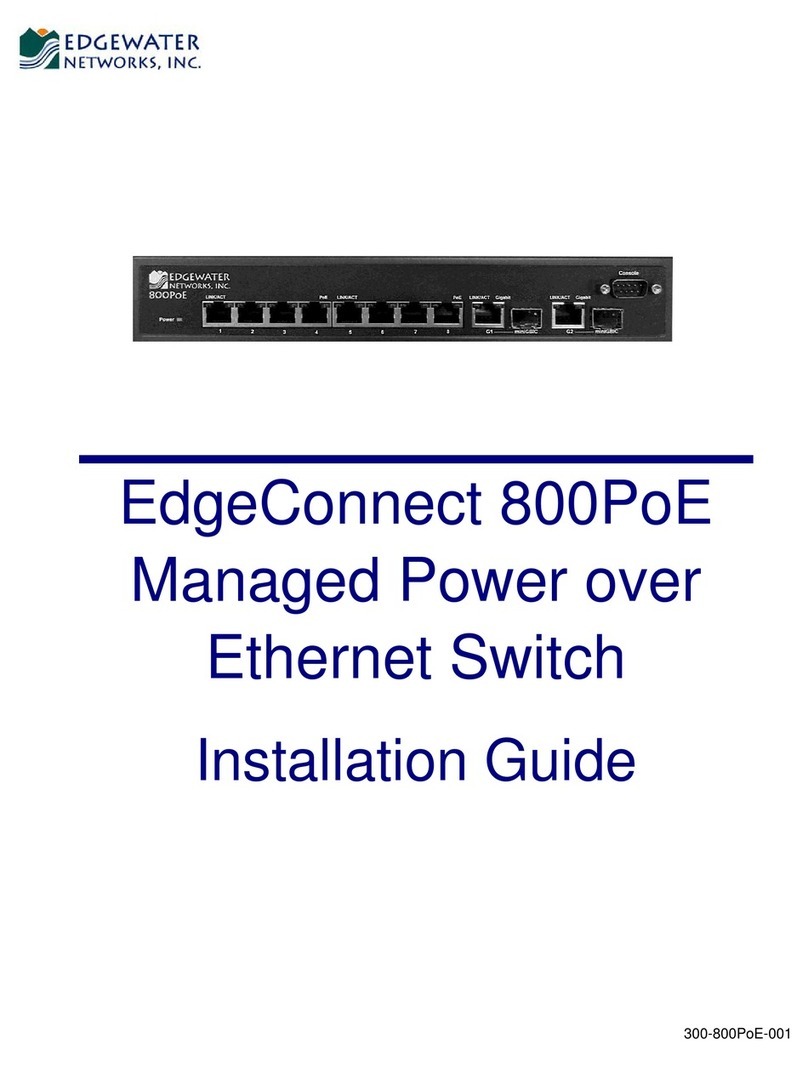Aeroflex Gaisler RT-SPW-ROUTER User manual

Copyright Aeroflex Gaisler AB June 2012, Version 1.2
Radiation-Tolerant 10x SpaceWire Router
Radiation Tolerant 6x SpaceWire Router with PCI
RT-SPW-ROUTER
Data Sheet and User’s Manual
GAISLER
Features
• SpaceWire Router compliant
with ECSS-E-ST-50-12C
• Non-blocking switch-matrix
connecting any input to any output
• Packet Distribution
• Group Adaptive Routing
• Path, Logical and Regional Logical addressing
• Two priority levels for output port arbitration
• Configuration port using RMAP, compliant with
ECSS-E-ST-50-52C
• 8x SpaceWire ports, full duplex, on-chip or off-
chip LVDS transceivers
• 2x external FIFO ports, 9-bit wide data paths
• Possible to cascade two routers without glue
logic via the FIFO ports
• 2x internal AMBA ports with DMA and RMAP
• PCI Initiator/Target interface, 32-bit, 33 MHz
• System-time distribution via all ports
• Timers on all ports to prevent deadlock
• Fault-tolerant design
Description
The Radiation-Tolerant SpaceWire
Router family is available as standard
components using the Actel RTAX and
RT ProASIC3 FPGAs. The fault
tolerant design of the router in
combination with the radiation tolerant
FPGA makes it ideally suited for space
and other high-rel applications.
Specification
• CCGA484, CQFP352, CCGA624
• Total Ionizing Dose (TID)
to 300 krad (Si, functional)
• Single-Event Latch-Up Immunity
(SEL) to LETTH > 117 MeV-cm2/mg
• Immune to Single-Event Upsets
(SEU) to LETTH > 37 MeV-cm2/mg
• 1.2-1.5V, 2.5V & 3.3V supply,
500 mW consumption (TBD)
• Up to 200 MBPS on SpaceWire links
Applications
The router implements a routing switch
as defined in the ECSS-E-ST-50-12C
SpaceWire links, nodes, routers and
networks standard, supporting all
mandatory and optional features.
Therouterimplementsuptotenexternal
routing ports and the mandatory
configuration port.
The configuration port provides access
toconfiguration andstatus registers,and
the routing table using the Remote
Memory Access Protocol (RMAP) as
defined in the ECSS-E-ST-50-52C
protocol standard.
The router also fully supports the
ECSS-E-ST-50-51C SpaceWire
protocol identification standard.
An optional PCI Initiator/Target
interface is available.

AEROFLEX GAISLER 2 RT-SPW-ROUTER
Copyright Aeroflex Gaisler AB June 2012, Version 1.2
Table of contents
1 Introduction..............................................................................................................................5
1.1 Overview .................................................................................................................................................5
1.2 Standard configurations...........................................................................................................................5
1.3 Signal overview.......................................................................................................................................6
2 Architecture..............................................................................................................................7
2.1 Cores........................................................................................................................................................7
2.2 Interrupts .................................................................................................................................................7
2.3 Memory map ...........................................................................................................................................8
2.4 Plug & play information..........................................................................................................................8
2.5 Specifications...........................................................................................................................................9
2.6 Signals ...................................................................................................................................................10
3 SpaceWire router....................................................................................................................12
3.1 Overview ...............................................................................................................................................12
3.2 Operation...............................................................................................................................................12
3.2.1 Port numbering........................................................................................................................12
3.2.2 Routing table...........................................................................................................................12
3.2.3 Output port arbitration ............................................................................................................13
3.2.4 Group adaptive routing ...........................................................................................................13
3.2.5 Packet distribution...................................................................................................................14
3.2.6 Port disable..............................................................................................................................14
3.2.7 Timers .....................................................................................................................................14
3.2.8 On-chip memories...................................................................................................................16
3.2.9 System time-distribution.........................................................................................................17
3.2.10 Invalid address error................................................................................................................17
3.2.11 Global configuration features..................................................................................................17
3.3 SpaceWire ports.....................................................................................................................................18
3.4 FIFO ports .............................................................................................................................................18
3.4.1 Transmitter..............................................................................................................................18
3.4.2 Receiver...................................................................................................................................19
3.4.3 Time-code transmit .................................................................................................................19
3.4.4 Time-code receive...................................................................................................................20
3.4.5 Bridge mode............................................................................................................................20
3.5 AMBA ports..........................................................................................................................................21
3.5.1 Overview.................................................................................................................................21
3.5.2 Operation.................................................................................................................................21
3.5.3 Receiver DMA channels .........................................................................................................23
3.5.4 Transmitter DMA channels.....................................................................................................29
3.5.5 RMAP target ...........................................................................................................................32
3.5.6 AMBA interface......................................................................................................................34
3.5.7 Registers..................................................................................................................................37
3.6 Configuration port .................................................................................................................................43
3.6.1 AMBA AHB slave interface ...................................................................................................43
3.6.2 Write commands.....................................................................................................................44
3.6.3 Read commands......................................................................................................................44
3.6.4 RMW commands ....................................................................................................................44
3.7 Registers................................................................................................................................................48
3.7.1 Reset value definitions............................................................................................................48
3.7.2 Register type definitions..........................................................................................................48

AEROFLEX GAISLER 3 RT-SPW-ROUTER
Copyright Aeroflex Gaisler AB June 2012, Version 1.2
3.8 Signal definitions and reset values ........................................................................................................56
3.9 Timing ...................................................................................................................................................58
4 SpaceWire encoder-decoder...................................................................................................60
4.1 Overview ...............................................................................................................................................60
4.2 Operation...............................................................................................................................................60
4.2.1 Overview.................................................................................................................................60
4.2.2 Link-interface FSM.................................................................................................................60
4.2.3 Transmitter..............................................................................................................................61
4.2.4 Receiver...................................................................................................................................61
4.2.5 Time interface .........................................................................................................................62
4.3 Receiver interface..................................................................................................................................63
4.3.1 Link errors...............................................................................................................................63
4.4 Transmitter interface..............................................................................................................................63
4.4.1 Link errors...............................................................................................................................64
4.5 Registers................................................................................................................................................64
5 PCI Initiator/Target ................................................................................................................65
5.1 Overview ...............................................................................................................................................65
5.2 Operation...............................................................................................................................................65
5.2.1 PCI Initiator.............................................................................................................................65
5.2.2 PCI Target ...............................................................................................................................66
5.2.3 Configuration ..........................................................................................................................66
5.2.4 Byte access..............................................................................................................................67
5.2.5 Error response.........................................................................................................................67
5.2.6 Interrupt controller (generation of PCI interrupt)...................................................................67
5.3 Registers................................................................................................................................................68
5.4 Signal definitions and reset values ........................................................................................................71
5.5 Timing ...................................................................................................................................................72
6 Status Registers......................................................................................................................73
6.1 Overview ...............................................................................................................................................73
6.2 Operation...............................................................................................................................................73
6.2.1 Errors.......................................................................................................................................73
6.2.2 Correctable errors....................................................................................................................73
6.2.3 Interrupts.................................................................................................................................73
6.3 Registers................................................................................................................................................73
7 Serial Debug Interface............................................................................................................75
7.1 Overview ...............................................................................................................................................75
7.2 Operation...............................................................................................................................................75
7.2.1 Transmission protocol.............................................................................................................75
7.2.2 Baud rate generation ...............................................................................................................76
7.3 Registers................................................................................................................................................76
7.4 Signal definitions and reset values ........................................................................................................77
7.5 Timing ...................................................................................................................................................77
8 JTAG Debug Interface............................................................................................................78
8.1 Overview ...............................................................................................................................................78
8.2 Operation...............................................................................................................................................78
8.2.1 Transmission protocol.............................................................................................................78
8.3 Registers................................................................................................................................................79

AEROFLEX GAISLER 4 RT-SPW-ROUTER
Copyright Aeroflex Gaisler AB June 2012, Version 1.2
8.4 Signal definitions and reset values ........................................................................................................79
8.5 Timing ...................................................................................................................................................79
9 Clock generation....................................................................................................................80
9.1 Overview ...............................................................................................................................................80
9.2 Signal definitions and reset values ........................................................................................................80
9.3 Timing ...................................................................................................................................................80
10 Reset generation.....................................................................................................................81
10.1 Overview ...............................................................................................................................................81
10.2 Signal definitions and reset values ........................................................................................................81
10.3 Timing ...................................................................................................................................................81
11 AMBA AHB controller with plug&play support...................................................................82
11.1 Overview ...............................................................................................................................................82
11.2 Operation...............................................................................................................................................82
11.2.1 Arbitration...............................................................................................................................82
11.2.2 Decoding.................................................................................................................................82
11.2.3 Plug&play information ...........................................................................................................82
11.3 Registers................................................................................................................................................83
12 AMBA AHB/APB bridge with plug&play support...............................................................84
12.1 Overview ...............................................................................................................................................84
12.2 Operation...............................................................................................................................................84
12.2.1 Decoding.................................................................................................................................84
12.2.2 Plug&play information ...........................................................................................................84
13 Electrical description .............................................................................................................85
13.1 Absolute maximum ratings ...................................................................................................................85
13.2 Operating conditions .............................................................................................................................85
13.3 Input voltages, leakage currents and capacitances................................................................................85
13.4 Output voltages, leakage currents and capacitances..............................................................................85
13.5 Clock Input voltages, leakage currents and capacitances......................................................................85
13.6 Power supplies.......................................................................................................................................85
14 Mechanical description..........................................................................................................86
14.1 Component and package .......................................................................................................................86
14.2 Pin assignment.......................................................................................................................................86
14.3 RTAX2000S/SL specific pins - CQ352 package...................................................................................94
14.4 RTAX2000S/SL specific pins - CG624 package...................................................................................95
14.5 RT3PE3000L specific pins - CG484 package.......................................................................................96
15 Reference documents.............................................................................................................97
16 Ordering information .............................................................................................................98
17 Change record........................................................................................................................99

AEROFLEX GAISLER 5 RT-SPW-ROUTER
Copyright Aeroflex Gaisler AB June 2012, Version 1.2
1 Introduction
1.1 Overview
The SpaceWire Router family is based on a common architecture from which standard configurations
are derived. The architecture is centered around the a non-blocking switch matrix which can connect
any input port to any output port.
All the addressing modes such as path, logical and regional logical are supported. Group adaptive
routing is fully supported, meaning that both path and logical addresses can be individually config-
ured to use from one up to all ports. A unique feature is the support for packet distribution, which can
be used to implement multicast and broadcast addresses. Output ports are arbitrated using two priority
levels with a round-robin scheme within each level.
The 10x SpaceWire router implements 8 external SpaceWire ports and 2 external FIFO ports. The
SpaceWire and FIFO interfaces are directly connected to the switch matrix.
The 6x SpaceWire router implements 4 external SpaceWire ports and a PCI initiator and target inter-
face (32-bit, 33 MHz) accessed via two internal AMBA ports with DMA and RMAP. In this configu-
ration, the AMBA Advanced High-speed Bus (AHB), to which the AMBA ports and the PCI interface
are connected, is used for high-speed communication between the switch matrix and the external PCI
interface. Supporting low-bandwidth items, such as configuration registers, are connected to the
AMBA Advanced Peripheral Bus (APB) which is accessed through an AHB to APB bridge.
The full SpaceWire router architecture includes the following modules: SpaceWire Router, PCI Initia-
tor/Target Interface, AMBA AHB Debug UART and AMBA AHB Status Register.
1.2 Standard configurations
Due to resource limitations, it is not possible to fit the full SpaceWire router architecture on a single
device. Therefore, sub-set configurations have been defined to suit applications with different inter-
facing needs. Table 1 below shows which functions are available in each of the configurations.
Table 1. Standard configurations
Configuration name 10x SpaceWire Router 6x SpaceWire Router with PCI
Configuration ID (CID) 1 2
SpaceWire Ports 8 4
FIFO Ports 2
AMBA Ports with RMAP 2
Configuration port with RMAP Yes Yes
Configuration port with AMBA Yes
PCI Initiator/Target and Interrupt Controller Yes
AMBA Status Register Yes
UART Debug Link Yes
JTAG Debug Link
FPGA and Package Actel RTAX2000S CCGA624 Actel RTAX2000S CCGA624
Actel RTAX2000S CQFP352 Actel RTAX2000S CQFP352
Actel RT3PE3000L CCGA484
SpaceWire Physical Layer LVTTL / LVDS (on-chip) LVTTL / LVDS (on-chip)

AEROFLEX GAISLER 6 RT-SPW-ROUTER
Copyright Aeroflex Gaisler AB June 2012, Version 1.2
1.3 Signal overview
Figure 1. Signal overview
dsutxdsurx
clk
resetn
rxclk
spw_rxdp[]
spw_rxdn[]
spw_rxsp[]
spw_rxsn[]
spw_txdp[]
spw_txdn[]
spw_txsp[]
spw_txsn[]
SpaceWire Links
Clock & Reset
UART Debug Link
dsutck
dsutms
dsutdi
dsutdo
JTAG Debug Link
PCI
pci_clk
pci_gnt
pci_rst
pci_idsel pci_stop
pci_perr
pci_frame
pci_devsel
pci_int
pci_irdy
pci_par
pci_trdypci_ad[31:0]
pci_cbe[31:0]
pci_req
pci_serr
Initiator & Target
txclk
Time-Code Interfaces
timeout0[]
tickout[]tickin[]
timein0[]
timein1[] timeout1[]
timecodeen
FIFO Interfaces
rxread[]
txchar0[]
txchar1[]
enbridge[]
rxchar0[]
rxchar1[]
txwrite[] txfull[]
txafull[]
rxcharav[]
rxaempty[]
Configuration linkrun[]
gerror
reload_timer[]
reload_ps[]
selfaddren
timeren
autodconnect
linkstartreq
instanceid[]
idivisor[]
cfglock
&
Status

AEROFLEX GAISLER 7 RT-SPW-ROUTER
Copyright Aeroflex Gaisler AB June 2012, Version 1.2
2 Architecture
2.1 Cores
The common architecture of the SpaceWire router family is based on cores from the GRLIB IP
library. The vendor and device identifiers for each core can be extracted from the plug & play infor-
mation. The used IP cores are listed in table 2.
2.2 Interrupts
The SpaceWire router family uses the same interrupt assignment for all configurations. See the
description of the individual cores for how and when the interrupts are raised. All interrupts are han-
dled by the interrupt controller and forwarded to the PCI bus. Note that this only applies to CID 2.
Table 2. Used IP cores
Core Function Vendor Device CID
AHBCTRL AHB Arbiter & Decoder 0x01 - 2
APBCTRL AHB/APB Bridge 0x01 0x006 2
GRSPWROUTER SpaceWire Router 0x01 - All
AMBA port 0x01 0x8A 2
AMBA configuration port 0x01 0x8B 2
PCIF PCI Initiator/Target 0x01 0x075 2
AHBUART Serial/AHB debug interface 0x01 0x007 2
AHBJTAG JTAG/AHB debug interface 0x01 0x01C -
AHBSTAT AHB failing address register 0x01 0x052 2
Table 3. Interrupt assignment
Core Interrupt Comment CID
GRSPWROUTER 1, 2 AMBA ports 0 and 1, respectively 2
PCIF 3 (spare for future use) 2
AHBSTAT 4 (spare for future use) 2

AEROFLEX GAISLER 8 RT-SPW-ROUTER
Copyright Aeroflex Gaisler AB June 2012, Version 1.2
2.3 Memory map
The SpaceWire router family uses the same memory map for all standard configurations. The memory
map shown in table 4 is based on the AMBA AHB address space. Access to addresses outside the
ranges will return an AHB error response. The detailed register layout is defined in the description of
each individual core. Note that this only applies to CID 2.
The control registers of most on-chip peripherals are accessible via the AHB/APB bridge, which is
mapped at address 0x80000000. The memory map shown in table 5 is based on the AMBA AHB
address space. Note that this only applies to CID 2.
2.4 Plug & play information
The LEON3FT RTAX family uses the same plug & play map for all standard configurations. The plug
& play memory map and bus indexes for AMBA AHB masters are shown in table 6 and is based on
the AMBA AHB address space. Note that this only applies to CID 2.
Table 4. AMBA AHB address range
Core Address range Area CID
PCIF 0x00000000 - 0x3FFFFFFF PCI memory area, 1 GByte 2
APBCTRL 0xFFE00000 - 0xFFEFFFFF APB bridge 2
PCIF 0xFFF00000 - 0xFFF1FFFF PCI I/O area 2
GRSPWROUTER 0xFFFC0000 - 0xFFFC0FFF Configuration area 2
AHB plug&play 0xFFFFF000 - 0xFFFFFFFF 2
Table 5. APB address range
Core Address range Comment CID
GRSPWROUTER 0xFFE00100 - 0xFFE001FF AMBA port 0 2
GRSPWROUTER 0xFFE00200 - 0xFFE002FF AMBA port 1 2
PCIF 0xFFE00300 - 0xFFE003FF 2
AHBUART 0xFFE00400 - 0xFFE004FF 2
AHBJTAG 0xFFE00500 - 0xFFE005FF -
AHBSTAT 0xFFE00600 - 0xFFE006FF 2
APB plug&play 0xFFEFF000 - 0xFFEFFFFF 2
Table 6. Plug & play information for AHB masters
Core Index Function Address range CID
GRSPWROUTER 0 AMBA port 0 0xFFFFF000 - 0xFFFFF01F 2
GRSPWROUTER 1 AMBA port 1 0xFFFFF020 - 0xFFFFF03F 2
PCIF 2 PCI Initiator/Target 0xFFFFF040 - 0xFFFFF05F 2
AHBUART 3 Serial/AHB debug interface 0xFFFFF060 - 0xFFFFF07F 2
AHBJTAG 4 JTAG/AHB debug interface 0xFFFFF080 - 0xFFFFF09F -

AEROFLEX GAISLER 9 RT-SPW-ROUTER
Copyright Aeroflex Gaisler AB June 2012, Version 1.2
The plug & play memory map and bus indexes for AMBA AHB slaves are shown in table 7 and is
based on the AMBA AHB address space.
The plug & play memory map and bus indexes for AMBA APB slaves are shown in table 8 and is
based on the AMBA AHB address space.
2.5 Specifications
Note 1: Refer to Actel RTAX and RT ProASIC3 data sheets [RTAX] and [RT3PE] for details.
Note 2: The pre-programmed Actel RTAX and RT ProASIC3 devices are shipped in all quality
levels supported by Actel, as defined in [RTAX] and [RT3PE], respectively.
Table 7. Plug & play information for AHB slaves
Core Index Function Address range CID
APBCTRL 0 AHB/APB Bridge 0xFFFFF800 - 0xFFFFF81F 2
GRSPWROUTER 1 Configuration area 0xFFFFF820 - 0xFFFFF83F 2
PCIF 2 PCI Initiator/Target 0xFFFFF840 - 0xFFFFF85F 2
Table 8. Plug & play information for APB slaves
Core Index Function Address range CID
GRSPWROUTER 0 AMBA port 0 0xFFEFF000 - 0xFFEFF017 2
GRSPWROUTER 1 AMBA port 1 0xFFEFF018 - 0xFFEFF01F 2
PCIF 2 PCI Initiator/Target 0xFFEFF020 - 0xFFEFF027 2
AHBUART 3 Serial/AHB debug interface 0xFFEFF028 - 0xFFEFF02F 2
AHBJTAG 4 JTAG/AHB debug interface 0xFFEFF030 - 0xFFEFF037 -
AHBSTAT 5 AHB failing address register 0xFFEFF038 - 0xFFEFF03F 2
Table 9. Specifications
Technology Actel RT Axcelerator Actel RT ProASIC3
Device RTAX2000S/SL RT3PE3000L
Link speed 200 MBPS 100 MBPS
Receiver clock 200 MHz 100 MHz
Transmitter clock 100 MHz (DDR) 50 MHz (DDR)
System clock 25 MHz (CID 1) / 33 MHz (CID 2) 25 MHz (CID 1)
PCI clock 33 MHz N/A
Power consumption 500 mW (TBD) 500 mW (TBD)
Package CQFP352, CCGA624 CCGA484
Total Ionizing Dose 1) 300 krad (Si) 15 krad (Si)
Single-Event Latch-Up Immunity (SEL)1) LETTH > 117 MeV-cm2/mg LETTH > 68 MeV-cm2/mg
Single-Event Upsets (SEU) 1) LETTH > 37 MeV-cm2/mg LETTH > 6 MeV-cm2/mg (before TMR)
Supply voltage 1.5 V, 2.5 V & 3.3 V 1.2 V -1.5 V, 2.5 V & 3.3 V
Screening level 2) B, E, EV and PROTO B

AEROFLEX GAISLER 10 RT-SPW-ROUTER
Copyright Aeroflex Gaisler AB June 2012, Version 1.2
2.6 Signals
The common architecture has the external signals shown in table 10.
Table 10. External signals
Name Usage Direction Polarity CID
clk Main system clock In - All
resetn System reset In Low All
dsutx Debug UART transmit data Out Low 2
dsurx Debug UART receive data In Low 2
dsutck Debug JTAG Clock In - -
dsutms Debug JTAG Mode In High -
dsutdi Debug JTAG Input In High -
dsutdo Debug JTAG Output Out High -
rxclk SpaceWire link receive clock In - All
txclk SpaceWire link transmit clock In - All
spw_rxdp[7:0] Data input, positive In, LVDS High All 1) 3)
spw_rxdn[7:0] Data input, negative In, LVDS Low All 1) 3)
spw_rxsp[7:0] Strobe input, positive In, LVDS High All 1) 3)
spw_rxsn[7:0] Strobe input, negative In, LVDS Low All 1) 3)
spw_txdp[7:0] Data output, positive Out, LVDS High All 1) 3)
spw_txdn[7:0] Data output, negative Out, LVDS Low All 1) 3)
spw_txsp[7:0] Strobe output, positive Out, LVDS High All 1) 3)
spw_txsn[7:0] Strobe output, negative Out, LVDS Low All 1) 3)
spw_rxd[7:0] Data input In, High All 2) 3)
spw_rxs[7:0] Strobe input In High All 2) 3)
spw_txd[7:0] Data output Out High All 2) 3)
spw_txs[7:0] Strobe output Out High All 2) 3)
timecodeen Enable time-code functionality In High 1
tickin[1:0] Tick input signals for FIFO interfaces In High 1
timein0[7:0] Time input signals for FIFO 0 interface In - 1
timein1[7:0] Time input signals for FIFO 1 interface In - 1
tickout[1:0] Tick output signals for FIFO interfaces Out High 1
timeout0[7:0] Time output signals for FIFO 0 interface Out - 1
timeout1[7:0] Time output signals for FIFO 1 interface Out - 1
rxread[1:0] Receiver FIFO read signals for FIFO interfaces In High 1
rxchar0[8:0] Receiver character signals for FIFO 0 interface Out - 1
rxchar1[8:0] Receiver character signals for FIFO 1 interface Out - 1
txwrite[1:0] Transmitter FIFO write signals for FIFO interfaces In High 1
txchar0[8:0] Transmitter character signals for FIFO 0 interface In - 1
txchar1[8:0] Transmitter character signals for FIFO 1 interface In - 1
txfull[1:0] Transmitter full signal for FIFO interfaces Out High 1

AEROFLEX GAISLER 11 RT-SPW-ROUTER
Copyright Aeroflex Gaisler AB June 2012, Version 1.2
Note 1: These signals are only used in configuration with on-chip LVDS drivers.
Note 2: These signals are only used in configuration with off-chip LVDS drivers.
Note 3: All bus signal elements are not used in all listed configurations. See pin assignment at end
of document for details.
txafull[1:0] Transmitter almost full signal for FIFO interfaces Out High 1
rxcharav[1:0] Receiver data available signal for FIFO interfaces Out High 1
rxaempty[1:0] Receiver empty signal for FIFO interfaces Out High 1
enbridge[1:0] Enables bridge mode for the FIFO interfaces In High 1
linkrun[7:0] SpaceWire link in run state when asserted Out High All 3)
gerror Global error Out High All
reload_ps[5:0] Reset value for the timer prescaler. Mapped to bits 13, 11, 9, 7, 5
and 3 of the prescaler register, other bits to 0 at reset. In - All
reload_timer[3:0] Reset value for the port timer registers. Mapped to bits 8, 6, 4 and
2 of the timer registers, other bits cleared to 0 at reset. In - All
timeren Reset value for the timer enable bit in the port control registers In High All
selfaddren Reset value for selfaddren register bit In High All
linkstartreq Reset value for the linkstartreq register bit In High All
autodconnect Reset value for the autodconnect register bit In High All
instanceid[3:0] Reset value for the instance id field of the version/instance id reg-
ister. Sets bits 3:0, other bits cleared to 0 at reset. In - All
idivisor[3:0] Reset value for the initialization divisor register and the
SpaceWire port run-state divisor registers. Sets bits 3:0, other bits
cleared to 0 at reset.
In - All
cfglock Lock configuration port accesses from all ports except port 1
when asserted In High All
pci_clk PCI clock In - 2
pci_rst PCI reset In Low 2
pci_frame Cycle frame BiDir Low 2
pci_irdy Initiator ready BiDir Low 2
pci_trdy Target ready BiDir Low 2
pci_stop Stop BiDir Low 2
pci_idsel Device select during configuration In High 2
pci_devsel Device select BiDir Low 2
pci_par Parity signal BiDir High 2
pci_perr Parity error BiDir Low 2
pci_serr System error BiDir Low 2
pci_req Request signal BiDir Low 2
pci_gnt Grant signal In Low 2
pci_cbe[3:0] Bus command and byte enable BiDir Low 2
pci_ad[31:0] Address and Data bus BiDir High 2
pci_int Interrupt signal Out Low 2
Table 10. External signals
Name Usage Direction Polarity CID

AEROFLEX GAISLER 12 RT-SPW-ROUTER
Copyright Aeroflex Gaisler AB June 2012, Version 1.2
3 SpaceWire router
3.1 Overview
The SpaceWire router core implements a SpaceWire routing switch as defined in the ECSS-E-ST-50-
12C standard. It provides an RMAP target for configuration at port 0 used for accessing internal con-
figuration and status registers. In addition to this there are three different external port types:
SpaceWire links, FIFO interfaces and AMBA interfaces. An AHB slave interface is also provided for
accessing the port 0 registers from the AHB bus. Group adaptive routing and packet distribution are
fully supported (two ports up to all ports can be assigned to an address). System time-distribution is
also supported. Timers are available for each port to prevent deadlock situations.
3.2 Operation
The router ports are interconnected using a non-blocking switch matrix which can connect any input
port to any output port. Access to each output port is arbitrated using a round-robin arbitration
scheme. A single routing-table is used for the whole router. Access to the table is also arbitrated using
a round-robin scheme.
The ports consist of configuration port 0 and three different types of external ports: SpaceWire links,
FIFO interfaces and AMBA interfaces.
All the ports regardless of their type have the same interface to the switch matrix and behave in the
same manner. The difference in behavior is on the external side of the port. The SpaceWire ports pro-
vide standard SpaceWire link interfaces using either on- or off-chip LVDS. The FIFO interfaces store
characters in two FIFOs which are accessed using 9-bit wide data paths with read/write signals. Lastly
the AMBA ports transfer characters from and to an AHB bus using DMA. The four different port
types are described in further detail in sections 3.3, 3.4, 3.5 and 3.6.
3.2.1 Port numbering
The ports are numbered in the following order: configuration port, SpW ports, AMBA ports, FIFO
ports. The configuration port is always present and has number 0. If SpW ports are present in the
router they are numbered starting from number 1. If AMBA ports are present they are numbered start-
ing from the last SpW ports. If no SpW ports are present the AMBA ports start at number 1. Lastly,
the FIFO ports are numbered starting after the last AMBA port, SpW port or at number 1 depending
on if AMBA ports and SpW ports are present respectively.
For example if 7 SpW ports and 4 FIFO ports are included in the router they will have port numbers 1-
7 and 8-11. If 16 SpW ports, 2 AMBA ports and 7 FIFO ports are included they have port numbers 1-
16, 17-18 and 19-25 respectively.
3.2.2 Routing table
A single routing table is provided. The access to this routing table is arbitrated using a round-robin
arbiter with each port being of equal priority. The operation is pipelined and one lookup can be done
each cycle. This way the maximum latency is equal to the number of ports in the router minus one.
The impact on throughput should be negligible provided that packets are not incoming at the same
time. The probability for this is higher when the traffic only consist of very small packets sent contin-
uously (the average size being about the same as the number of ports). This should be a very uncom-
mon case. Latency is still bounded and probably negligible in comparison to other latencies in most
systems. The benefit is a reduced area enabling the router to be implemented with a higher number of
ports on many FPGA technologies.

AEROFLEX GAISLER 13 RT-SPW-ROUTER
Copyright Aeroflex Gaisler AB June 2012, Version 1.2
Since the latency for the lookup is very small and deterministic there is not much to gain by having
configurable priorities for this. Priorities are instead used for arbitrating packets contending for an
output port as described in the next section.
The routing table and all the configuration registers are configured through an RMAP target or an
AHB slave interface which use the same routing table as the logic handling packet traffic. They do not
introduce any extra latency because they have lower priority than the packet traffic and thus are only
allowed access on cycles when no lookup is needed for packets. This can slow down configuration
accesses but they are probably mostly done before packet traffic starts and very seldom afterwards.
Logical addresses have a routing table entry containing a priority bit, header deletion enable bit and a
entry enable bit. The routing table entry is enabled by writing a 1 to the enable bit. It can be disabled
again by writing a 0. The contents of the routing table is undetermined after reset and should not be
read. When a routing table entry is disabled, packets with a destination address corresponding to that
entry will be discarded and the invalid address error bit asserted.
Before the routing table entry is enabled the corresponding port setup register must be initialized. The
port setup register should be written with ones to one or more bits to enable packets to be transmitted
on the ports corresponding to the bit numbers. See sections 3.2.4 and 3.2.5 for more details on how to
use the port setup register. If the port setup register is not initialized but the routing table entry is
enabled packets with that logical address will be discarded and the invalid address error bit asserted.
The mechanism is the same for path addresses except that they do not have a routing table entry and
header deletion is always enabled. Packets will be routed to the output corresponding to the path
address in the packet even if the port setup register has not been initialized. For group adaptive routing
and packet distribution to be used the port setup register must be initialized also for path addresses.
The routing table entries are also marked as invalid before they have been written the first time. When
the entries are invalid, packets with the corresponding logical address will be discarded and an invalid
address error bit asserted.
3.2.3 Output port arbitration
Each output port is arbitrated individually using two priority levels with round-robin at each level.
Each path or logical address can be configured to be high or low priority. In this case the delays can be
very long (compared to when arbiting for access to the routing table) before the next arbitration
because packets can be very large and the speed of the data consumer and the link itself cannot be
known. In this case priority assignments can have a large impact on the amount of bandwidth a source
port can use on a destination port.
The priority for path addresses is set in the port’s control register with the port number corresponding
to the path address. For logical addresses the priority is set in the routing table entry.
3.2.4 Group adaptive routing
Group adaptive routing is used to enable a packet to be transmitted on several different paths. For
example a packet with address 45 can be enabled to be transmitted on port 1 and 2. If port 1 is busy
when a packet with address 45 arrives it is transmitted on port 2 instead if not busy.
Group adaptive routing is used if bit 0 in the port setup register for the corresponding path or logical
address is 0. Each bit in the register corresponds to the port with the same number as the bit index. So
if bit 5 is set to 1 at address offset 0x80 it means that incoming packets with logical address 32 can be
transmitted on port 5. If only one bit is set for an address all packets with that address will be transmit-
ted on that port. If one or more bits are set the group adaptive function is used and the packet is trans-
mitted on the first available port with a bit set to 1 starting from the lowest number. A port being

AEROFLEX GAISLER 14 RT-SPW-ROUTER
Copyright Aeroflex Gaisler AB June 2012, Version 1.2
available means that no other packet transmission is active at the moment and also for SpaceWire
links that the link is in run-state. For path addresses the bit corresponding to the path address will
always be set. This is done as specified in the standard which requires a packet with a path address to
be transmitted on the port with the same number as the address. The standard does not mention what
should happen when group adaptive routing is used for path addresses but in this router the bit corre-
sponding to the port number of the path address is always set so that the packet can be transmitted on
that port also when group adaptive routing is used.
For logical addresses the corresponding routing table entry and port setup register must be valid for
the packet to be routed (otherwise it is discarded). There is no default port as with path addresses so at
least one bit in the port setup register must be 1 for the packet to be routed otherwise it is discarded.
3.2.5 Packet distribution
Packet distribution can be used to implement multicast and broadcast addresses. Packets with logical
address 50 can for example be configured to be transmitted on ports 1, 2 and 3 while address 51 can
be configured to be transmitted on all ports (broadcast).
When packet distribution is enabled the group adaptive routing register is used to determine the ports
that a packet should be transmitted on. Packet distribution is enabled for a path or logical address by
setting bit 0 in the corresponding port setup register to 1. The packet will be transmitted on all the
ports with a bit set to 1 in the register. This means that if one of the ports enabled for packet distribu-
tion is busy the router will wait for it to become free before transmitting on any of the ports. Due to
the wormhole routing implementation the slowest link will determine the speed at which a packet is
transmitted on all the ports.
When packet distribution is used with path addresses the port with the same number as the address
will always be enabled (as for group adaptive routing).
3.2.6 Port disable
The disable port bit in the port’s control register can be used to disable a port for data traffic. It will
behave just like if the physical port was not existing. Packets transmitted to it will be spilt and the
invalid address bit on the source port is set. Packets received to the port will be silently discarded, no
status bits are set.
All ports except the configuration port (0) and port 1 can be disabled to prevent the situation of all
ports being locked out from happening.
3.2.7 Timers
Timers are individually enabled for each port by writing the timer enable bit in the port control regis-
ter. When timers are enabled during packet transmission on a port the timer is reset each time a char-
acter is transmitted. If the timer expires the packet will be discarded and an EEP is inserted on all the
ports to which the packet was transmitted (can be more than one if packet distribution was used). It
does not matter if it is the output port or source port which is stalling. The blocking situation is always
detected at the source port which handles the spilling. It also does not matter if the stall is caused by
the link being stopped or lack of credits, the discard mechanism is always the same. When the timers
are not implemented or disabled the source and destination ports will always block until the blocking
situation is resolved.
The timers use a global prescaler and an individual timer per port. Both the prescaler and the individ-
ual timer tick rate can be configured through the configuration port.

AEROFLEX GAISLER 15 RT-SPW-ROUTER
Copyright Aeroflex Gaisler AB June 2012, Version 1.2
In group adaptive routing mode the packet will be spilt if no characters have been transmitted for the
timeout period after being assigned to a port. For packet distribution a packet will be spilt if no char-
acter has been transmitted for the timeout period after being assigned to all the ports. This means that
it is enough for one port to stall for the packet to timeout and be spilt.
The behavior described above also means that the timeout is handled in the same way regardless of
the port type (SpW, FIFO or AMBA).
If a destination port is disabled it behaves as if it is not existing and will not be used thus being spilt
immediately. Timers are not applicable in that case. For group adaptive routing and packet distribution
disabled ports are also masked before transmission starts and will not affect timers.
Details for the different scenarios will be listed in the remaining sub-sections.
3.2.7.1 Timers disabled
If timers are disabled packets will always wait indefinitely regardless of stall reason. In the case that
timers are present but are enabled on some ports and disabled on others it is always the source port
that determines whether the timer will be active or not. This means that if a packet arrives at port 2
which has its timer enabled and it is routed to port 4 which has timers disabled a timer will be active
for that packet routing and transmission. The same applies for group adaptive routing and packet dis-
tribution.
3.2.7.2 Timer enabled and output port not in run state
The timer is started when the packet arrives and if the link has not entered run-state until the timer
expires the packet will be spilt. No EEP will be written to the destination port in this case. If the link
start on request feature has been enabled the router will try to start the link but still only waits for the
timeout period for the link to start.
3.2.7.3 Timer enabled and output port in run state but busy with other transmission
The packet will wait indefinitely until the destination port becomes free. In the case that the destina-
tion port is stalled the port currently sourcing the packet for it has to have its timer enabled and spill
the packet before the new port can be allocated for it. If the port stalls again the new port will also spill
its packet after the timeout period. In this case and EEP will be written to the destination port since the
transmission of the packet had started.
3.2.7.4 Timer enabled and group adaptive routing is enabled, ports not running
The timer is started when the packet arrives and if no port has been allocated until the timer expires
the packet will be spilt. If link start on request is enabled the router will try to start all the links.
3.2.7.5 Timer enabled and group adaptive routing enabled, ports running but busy
The packet will wait until one port becomes free and then start transmitting. The timer is not started
while waiting for busy ports.
3.2.7.6 Timer enabled and packet distribution enabled, ports not running
If at least one of the destination ports is not running the timer is started and the packet will be dis-
carded if all the ports are not running when the timer expires.

AEROFLEX GAISLER 16 RT-SPW-ROUTER
Copyright Aeroflex Gaisler AB June 2012, Version 1.2
3.2.7.7 Timer enabled and packet distribution enabled, ports running but busy
If at least one port is busy but all are running when packet distribution is enabled the packet will wait
indefinitely. When the transmission has started the timer is restarted each time a character is transmit-
ted and if the timer expires the remaining part of the packet is spilt and an EEP written to all the desti-
nation ports.
3.2.7.8 Timer functionality when accessing the configuration port
Timers work in the same way when accessing the configuration port as for the other ports. When the
command is being received by the RMAP target the timer on the source port will trigger if the source
of the command is too slow, spill the remaining part of the packet and insert an EEP to the configura-
tion port. The RMAP target will always be able to receive the characters quick enough. If the source is
too slow when the reply is sent the configuration port’s timer will trigger and the remaining part of the
packet is spilled and an EEP is inserted. This is to prevent the configuration port from being locked up
by a malfunctioning source port.
3.2.8 On-chip memories
There are two memory blocks in the routing table, one for the port setup registers and one for the rout-
ing table. The port setup memory bit width is equal to the number of ports including the configuration
port with depth 256. The routing table is 256 locations deep and 2 bits wide.
Each port excluding the configuration port also have FIFO memories. The SpaceWire ports have one
FIFO per direction (rx, tx) which are 9-wide. The FIFO ports have the exact same FIFO configuration
as the SpaceWire ports.
The AMBA ports have one 9-bit wide receiver FIFO and two 32-bit wide AHB FIFOs.
Parity is used to protect the memories and up to four bits per word can be corrected and there is a sig-
nal indicating an uncorrectable error.
If a memory error occurs in the port setup table or the routing table the memory error (ME) bit in the
router configuration/status register is set and remains set until cleared by the user. If a memory error is
detected in any of the ports FIFO memories the memory error (ME) bit in the respective port status
register is set and remains set until cleared by the user. The ME bits are only set for uncorrectable
errors.
When an uncorrectable error is detected in the port setup or routing table when a packet is being
routed it will be discarded. Unocrrectable errors in the FIFO memories are not handled since they
only affect the contents of the routed packet not the operation of the router itself. These type of errors
should be caught by CRC checks if used in the packet.
The ME bit for the ports is only usable for detecting errors and statistics since there is no need to cor-
rect the error manually since the packet has already been routed when it is detected. The ME indica-
tion for the routing table and port setup registers can be used for starting a scrubbing operation if
detected. There is also an option of having automatic scrubbing (see section 3.2.8.1)
3.2.8.1 Autoscrub
With autoscrubbing the routing table and port setup registers will be periodically read and rewritten.
This is done to prevent buildup of SEUs to cause an uncorrectable error in the memories. It will run in
the background and has no impact on routing table lookup for traffic but can delay configuration
accesses with two cycles.

AEROFLEX GAISLER 17 RT-SPW-ROUTER
Copyright Aeroflex Gaisler AB June 2012, Version 1.2
The scrubber starts at address 0 and simultaneously writes one location in the port setup memory and
the routing table memory. It then waits for a timeout period until it writes the next word. Eventually
the last location is reached and the process starts over from address 0.
The period between each word refresh is approximately 226 core clock cycles. The scrubber uses a
free slot when data traffic does not need to perform a table lookup to read and write the memories
which causes a small indeterminism in the period.
3.2.9 System time-distribution
The router contains a global time-counter register which handles system time-distribution. All the dif-
ferent port types support time-code transmission. Incoming time-codes on the ports are checked
against the time-counter which is then updated. If time-code was determined to have a count value
one more modulo 64 than the previous value then a tick is generated and the time-code is forwarded to
all the other ports. The time-codes are also forwarded to the FIFO and AMBA ports where they
appear on their respective external interfaces. Time-codes can also be transmitted from the FIFO and
AMBA ports. In that case they are also compared to the time-counter and propagated to the other
ports if valid.
The current router master time-counter and control flag values can be read through the configuration
port (see the time-code register in section 3.7).
In default mode the router does not check the control flags so time-codes will be accepted regardless
of their value. If the TF bit in the router configuration/status register is set to 1 time-code control flag
filtering is enabled and the time-codes are required to have the control flags set to “00” to be accepted,
otherwise they are dropped when received.
After reset all the ports are enabled to receive and transmit time-codes. The TE bit in a port’s control
register can be set to 0 to disable time-code transmission and reception on that port.
Time-code transfers can also be disabled globally using a signal.
3.2.10 Invalid address error
An invalid address error occurs when a port receives a packet with an destination address that belongs
to one or more of the three following groups:
1. Destination address is a path address corresponding to a non-existing port number. For example if
the router only has 8 ports and a packet has destination address 15 this error will occur. If a router has
31 ports (32 including the configuration port) this error cannot occur.
2. Destination address is a logical address corresponding to a routing table entry which has not been
configured. The routing table entries start at address 0x480.
3. Destination address is a logical address corresponding to a port setup register which has not been
configured. The port setup registers start at address 0x80 for logical addresses.
4. The destination port determined either through physical or logical address has the disable (DI) bit
set in the port control register.
3.2.11 Global configuration features
3.2.11.1 Self addressing
Normally the ports are allowed to address themselves i.e. a packet is received on a port with a destina-
tion address configured to be transmitted on the same port (which the packet was received on). This

AEROFLEX GAISLER 18 RT-SPW-ROUTER
Copyright Aeroflex Gaisler AB June 2012, Version 1.2
can be disabled by setting the self addressing enable (SA) bit in the router configuration/status register
to 0. The reset value of this bit is set using a signal.
This also applies to group adaptive routing and packet distribution. When group adaptive routing is
enabled for an address a packet with that destination address will be spilt due to self-addressing only
if the packet is actually routed to the source port. That is if ports 1 and 2 are enabled for address 1 and
a packet with address 1 arrives and it is routed to port 2 the transfer will be performed normally. If it is
routed to port 1 and self-addressing is disabled it will be discarded.
For packet distribution the packet will always be discarded if the source port is included in the list of
destination ports since the packet will be sent to all destinations.
3.2.11.2 Link start on request
Ports can be configured to start automatically when a packet is waiting to be transmitted on it. This is
done by setting the LS bit in the router configuration/status register to 1. If the port link is disabled it
will override the start feature and the link will not start. The reset value of this bit is set using a signal.
This feature is only applicable for SpaceWire ports.
If the linkstart bit for the port is set the setting for the link start on request bit will have no effect. The
link will continue to be started until a ‘0’ is written to the linkstart bit of the port or if the auto discon-
nect feature is enabled (see next section).
3.2.11.3 Auto disconnect
If the link was started by the link start feature the auto disconnect feature can be enabled to automati-
cally stop the link if inactive during a timeout period. The auto disconnect feature is enabled by set-
ting the AD bit in the router configuration/status register. The reset value is set using a signal. This
feature is only applicable to SpaceWire ports.
The link will be disconnected under the following conditions. The link start on request feature is
enabled and the link was not in run-state when the packet arrived at the output port. Then the link will
be disconnected when the packet transmission has finished (output port free), the transmit FIFO is
empty, no receive operation is active and the timeout period has expired since the last of the require-
ments for disconnect (the ones listed here) became true.
3.3 SpaceWire ports
When a port is configured as a SpaceWire link it consists of a SpaceWire codec with FIFO interfaces.
All the configurable parameters for the link are accessible through the router configuration port (see
the register section for the configurable parameters).
3.4 FIFO ports
A port configured as a FIFO port contains one FIFO in each direction to/from the switch matrix.
3.4.1 Transmitter
The transmitter FIFO interface consists of the following signals: txfull, txafull, txwrite, txchar,
txcharcnt. Figure 2 illustrates the write operation. Note that txfull would only be asserted as illustrated
in the figure when txcharcnt is 4 if the FIFO size is 4 (which is not the case typically).

AEROFLEX GAISLER 19 RT-SPW-ROUTER
Copyright Aeroflex Gaisler AB June 2012, Version 1.2
Txwrite is the write signal and each time when asserted on the rising edge of the clock the value on
the txchar signal will be written into the transmitter FIFO if it is not full. If it is full the character will
be dropped. Txcharcnt indicates the number of characters currently in the FIFO. Txfull is asserted
when the FIFO is full and txafull is asserted when the FIFO is almost full.
The transmitter FIFO can be reset through the port’s control register using the TF bit.
3.4.2 Receiver
The receiver FIFO interface consists of the following signals: rxread, rxchar, rxcharav and rxaempty.
Figure 3 illustrates the read operation. Note that rxcharav would only be deasserted as illustrated in
the figure if the FIFO contained 4 characters.
Each time rxread is asserted on the rising edge of the clock a new character will be available on the
rxchar output the next cycle if available. If the FIFO is empty the value is undefined. Rxcharav is
asserted when the FIFO contains at least one character. Rxaempty is asserted when the FIFO is almost
empty.
The receiver FIFO can be reset using the RF bit in the port’s control register.
3.4.3 Time-code transmit
The time-code transmit interface consists of the following signals: tickin, timein. Figure 4 illustrates
the tickin operation.
Figure 2. Transmitter FIFO interface write cycle.
txcharcnt
txwrite
txchar
txfull
clk
D0
1
D1 D2
24
D3
3
Figure 3. Receiver FIFO interface read cycle.
rxread
rxchar
rxcharav
clk
D0 D2 X
D3
D1

AEROFLEX GAISLER 20 RT-SPW-ROUTER
Copyright Aeroflex Gaisler AB June 2012, Version 1.2
3.4.4 Time-code receive
The time-code receive interface consists of the following signals: tickout, timeout. Figure 5 illustrates
the tickout operation.
The clock that all the interface signals are synchronized to is the same as the core clock (the clock that
everything except the SpaceWire links’ transmitters and receivers are running on). It can run on any
frequency but to support the maximum throughput it has to be at least one eighth of the maximum link
bitrate.
3.4.5 Bridge mode
The FIFO ports normally operate in standard mode which has been described so far in this section.
But they can also be set in bridge mode through the bridge enable (BE) bit in the port’s control regis-
ter. The reset value of this signal is set through an input signal so this mode can be enabled per default
after reset.
In bridge mode two FIFO ports can be connected together with automatic packet and time-code trans-
fer without any glue logic. Table 11 shows how the signals should be mapped. Rxaempty and txafull
are unused in this mode.
Figure 4. Time interface tickin operation.
tickin
clk
timein T0 T1 T2
Figure 5. Time interface tickout operation.
tickout
clk
timeout T0 T1 T2
Table of contents
